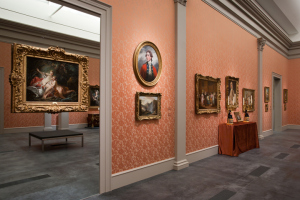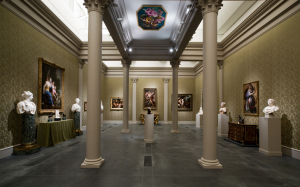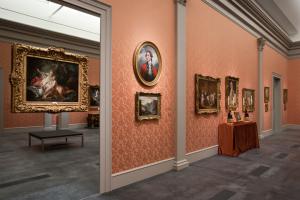
Eye for the Sensual: Selections from the Resnick Collection gallery installation
For the past few months I have been in the brand new Resnick Pavilion every day during the installation of its three inaugural shows. Two of the exhibitions, Fashioning Fashion and Eye for the Sensual, were designed by Pier Luigi Pizzi and Massimo Gasparon, opera/costume designers from Italy.
Since all of the pieces in Eye for the Sensual are part of Lynda and Stewart Resnick’s personal collection, Pizzi and Gasparon wanted the show to look like it was hung in someone’s home; albeit a sumptuous, elegant, palatial home. I spoke with Massimo last week to find out more about the wall coverings, which are made of a fabric created by the Italian company Rubelli.

Eye for the Sensual: Selections from the Resnick Collection gallery installation
Housed in a Venetian palace, Rubelli has been around for over 200 years and has historically created beautiful fabrics for nobility; they are now doing a lot of restoration. Rubelli has an archive housing a collection of over 6,000 textile samples ranging from the late fifteenth century to mid-twentieth century from Europe, the East, Africa, and the Americas. From this amassment, they have created fabrics for La Fenice in Venice, La Scala in MIlan, San Carlo Theatre in Naples, the Bolshoi Theater in Moscow, Cologne de Buenos Aires, and the Museo Verdi in Parma. "They did all of this stuff, with different patterns. You can have incredible quality; it can be very expensive. They have some fabrics that are at least 2,000–3,000 Euro each meter, because they are hand-made. They can do Brocatto [brocade] with gold [woven] inside—real gold! They can do whatever."
Looking through the archives at Rubelli, Pier Luigi found a pattern that he liked and had something similar made for Eye for the Sensual. "This is a pattern that simulates the ancient fabric, ruined by time; when it’s been worn," explains Massimo. The original swatch was made of silk, but because of import rules, fabrics must be fireproofed, and it changed the color of the silk; Pizzi decided on viscous fabric instead. "I think it’s really interesting to see what the light does because it almost makes the pattern disappear."
Meghan Moran



